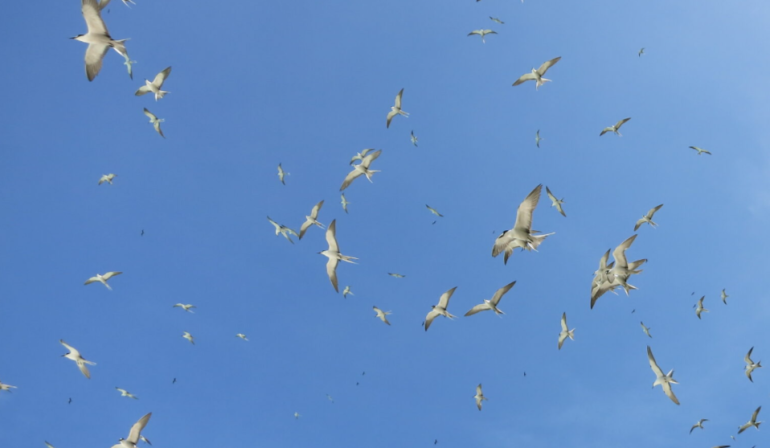
By Anna Dulisse via Mongabay
On an island chain in the middle of the Indian Ocean lies an invaluable treasure: “white gold.” While it may not be a gem to proposition a prospective fiancée with, it does protect the ocean’s most biodiverse ecosystem: coral reefs.
Casey Benkwitt, a research fellow at Lancaster University in the U.K., says she couldn’t be more thrilled about it.
“It’s exciting to learn and show something new about the world that we didn’t know before,” Benkwitt says. “Seabird poop is really good for the islands and the coral reefs around them.”
That’s right: poop. Corals absorb nutrients from this treasure trove of guano and it builds their resilience, according to Benkwitt and her team’s recently published paper in Science Advances.
 Benkwitt and her field assistants rise with the sun, take a small plastic boat to their study site, and disappear into a tropical lagoon for the day to make observations and collect coral samples. Image courtesy of Casey Benkwitt.
Benkwitt and her field assistants rise with the sun, take a small plastic boat to their study site, and disappear into a tropical lagoon for the day to make observations and collect coral samples. Image courtesy of Casey Benkwitt.
“Corals grow about twice as fast where there are seabirds present compared to areas where we’ve lost seabirds to invasive rats that eat and destroy their populations,” Benkwitt says.
From 2018-2021, Benkwitt and her team discovered that increased seabird-derived nutrients doubled coral growth rates and accelerated the recovery of corals in the Acropora genus after bleaching events to less than four years. Within a short period of time, they saw how seabird droppings helped coral reefs become more resilient.
Coral SOS
Most active at night, corals share a life cycle similar to the reef fish that they attract.
Once a year, when the moon and sea temperatures align, they spawn en masse, sending millions of tiny eggs and sperm out into the ocean to connect, develop into larvae, and settle down onto the ocean floor to start a new colony.
After establishing itself, a colony can thrive for thousands of years, supporting more than 25% of Earth’s marine life. But our warming world puts all of this at risk.
“When oceans get too hot, corals undergo what’s called bleaching, and if it stays too hot for too long, the corals can end up dying, which then affects the fish and everything else that lives on the reef and depends on the corals,” Benkwitt says.
In 2018, an Australian research team shared it findings that the average time between coral reef bleaching events had dropped from 27 years in the 1980s to just 5.9 years in 2016 due to warmer oceans.
A 2020 report by the U.N. Environment Programme said that unless nations take significant action to reduce greenhouse gas emissions, climate change will bleach all of the world’s coral reefs by the end of the century.
Emily Darling, a coral reef scientist at the Wildlife Conservation Society (WCS), recently told Mongabay that while “nature is incredibly resilient, we need to get our act together now if we want to have coral reefs, healthy, functioning oceans, as well as a functioning planet for all of us to live on.”
Benkwitt has witnessed bleaching events firsthand, and they concern her, but she says she wants the public to know that there’s hope.
“Most coral reef stories are depressing, and as an ecologist, a lot of the time, the patterns you see are not super clear,” Benkwitt says. “But the nutrients from seabird poop can help coral reefs recover after these big die-offs and grow a lot faster. With coral growth, it’s crazy. Year after year, we are snorkeling underwater and seeing such strong results. It’s really encouraging.
Rat-free is key
Scientists like Benkwitt are just beginning to understand how natural seabird-derived nutrients aid reef recovery following marine heat waves.
Birds like sooty terns (Onychoprion fuscatus), lesser noddies (Anous tenuirostris), red-footed boobies (Sula sula) and wedge-tailed shearwaters (Puffinus pacificus) fly out to the open ocean to eat fish and squid. When they return to roost on islands and poop, nutrients like nitrogen and phosphorus leech into the water, fertilizing the land, water and coral reefs.
When seabirds are abundant nearby, “coral take their nutrients up, grow faster, and this leads to faster recovery times after big bleaching and marine heat waves caused by climate change,” Benkwitt says.
Still, for many reefs, it’s a location lottery.
 After a squall one evening, dozens of disoriented red-footed boobies (Sula sula) spent the night on and pooped all over the Lancaster University researcher’s boats and dive gear. Image courtesy of Casey Benkwitt.
After a squall one evening, dozens of disoriented red-footed boobies (Sula sula) spent the night on and pooped all over the Lancaster University researcher’s boats and dive gear. Image courtesy of Casey Benkwitt.
In the late 1700s, when Western settlers first came to the Chagos Archipelago from Mauritius, they brought black rats (Rattus rattus). As a result, many islands on the archipelago are today infested with rats, which have decimated local seabird populations.
From the analysis of Acropora growth and isotope composition the she and her team studied, Benkwitt says she’s confident in her assessment that corals close to islands with healthy seabird populations fare far better than those near rat-infested ones, both in lead-up to and following a bleaching event.
“There was definitely an ‘Aha!’ moment during this study,” Benkwitt says. “We tagged corals and moved corals between islands, islands with seabirds and islands with rats. Then we went back every year and remeasured the coral growth. The visible differences are obvious and in your face. They grow about twice as fast where seabirds are present compared to areas where we’ve lost them.”
Of the 55 islands in the Chagos Archipelago, 34 have rats that tend to target seabird eggs and chicks. To bolster seabird populations and increase the nutrient supply to coral reefs around the Chagos Archipelago, Benkwitt’s team strongly suggests the rats need to go.
“[Researchers are] still working on getting funding, but there are plans to eradicate rats and restore native vegetation,” Benkwitt says, adding that rodent removal “has a high success rate and is pretty cheap compared to other management efforts.”
South Africa’s Marion Island is an example of what could be. Here, BirdLife International and its partners have diligently maintained the island as a critical seabird breeding site, ensuring it remains free of rats.
Robyn Adams, from the Mouse-Free Marion Project and BirdLife International, says rats and mice are “adaptable and voracious omnivores,” capable of driving an island into ecological impoverishment and pushing native species toward extinction. However, invasive control measures offer hope.
“The eradication of invasive mammalian predators is one of those rare conservation tools that solve a problem or threat, rather than just mitigating or containing it,” Adams says. “The outcomes have been remarkable.”
Benkwitt says she hopes the Chagos Archipelago can emulate Marion Island’s success, especially considering it’s not a controversial tactic.
“Most people are fine with eliminating rats from islands,” Benkwitt says.
Scuba diving for science
For several weeks in the period between March and May, Benkwitt lives on a large rusty ship, survives on hearty portions of ship-cooked food, and shares conversations and tubs of ice cream with an entirely male crew.
She and her field assistants rise with the sun, take a small plastic boat to their study site, slip on their neoprene suits and scuba tanks, and disappear into a tropical lagoon for the day to make observations and collect coral samples.
 Benkwitt measures the growth rate of Agropora corals in shallow reef ecosystems. Coral near rat-free islands grow twice as fast as those next to rat-infested ones. Image courtesy of Ines Lange.
Benkwitt measures the growth rate of Agropora corals in shallow reef ecosystems. Coral near rat-free islands grow twice as fast as those next to rat-infested ones. Image courtesy of Ines Lange.
Benkwitt says being on remote and untouched reefs, watching the sunrise over the ocean, and feeling alone and alive in the middle of the sea are all parts of a job she loves. But she adds it’s not as glamorous as some think.
“People assume you’re laying on a beach with a cocktail. But it’s the exact opposite of that,” Benkwitt says. “You wake up super early in the morning, are up until 10 or 11 at night, sunburned no matter how much sunscreen you put on, you get cold being in the water for six hours, and you smell like urine — whoever says they don’t pee in their wetsuit is lying. In general, it’s just a lot of work.”
In a related study from 2022, Benkwitt and her team looked at how seabird diversity and biomass, total weight and amount, influence nutrient flow to coral reefs. They found that both abundance and diversity mattered: larger and more diverse seabird populations had better outcomes for offshore corals.
But like any good scientist, Benkwitt still has a lot of questions.
“We just don’t know a ton about tropical seabirds or their poop,” Benkwitt says. “There’s a lot more going on at the genetic and molecular level … We’re working on it.”
It takes a community to conserve coral
Due to this year’s El Niño event, exacerbated by climate change, Benkwitt and other researchers are anticipating bleaching events in vulnerable coral reef ecosystems worldwide, including the Chagos Archipelago.
Benkwitt will visit the study site later this year, even as her work on this specific study is wrapping up. She urges those who care about coral reefs to do what they can to protect and support them.
She says organizations, governments, educational institutions and philanthropists can bolster seabird populations in the Indian Ocean and elsewhere by protecting them and their eggs from human exploitation, replanting native island vegetation, implementing long-term invasive predator control programs, and actively attracting or relocating seabirds to restored islands.
 Terns fly over Casey Benkwitt’s and her assistants on a remote and rat-free island in the Chagos Archipelago. Image courtesy of Casey Benkwitt.
Terns fly over Casey Benkwitt’s and her assistants on a remote and rat-free island in the Chagos Archipelago. Image courtesy of Casey Benkwitt.
Citizens can also help by urging their governments to take global heating seriously and aggressively reduce greenhouse gas emissions.
Benkwitt says she knows there are real challenges ahead, but she adds it’s possible to be both informed and optimistic.
“There are things we can do that are pretty easy,” Benkwitt says. “There are coral reefs that are doing well at the moment, and we can keep enhancing things like seabirds that may help them thrive into the future. Not all hope is lost.”
To read the original article click here.




 Benkwitt and her field assistants rise with the sun, take a small plastic boat to their study site, and disappear into a tropical lagoon for the day to make observations and collect coral samples. Image courtesy of Casey Benkwitt.
Benkwitt and her field assistants rise with the sun, take a small plastic boat to their study site, and disappear into a tropical lagoon for the day to make observations and collect coral samples. Image courtesy of Casey Benkwitt. After a squall one evening, dozens of disoriented red-footed boobies (Sula sula) spent the night on and pooped all over the Lancaster University researcher’s boats and dive gear. Image courtesy of Casey Benkwitt.
After a squall one evening, dozens of disoriented red-footed boobies (Sula sula) spent the night on and pooped all over the Lancaster University researcher’s boats and dive gear. Image courtesy of Casey Benkwitt. Benkwitt measures the growth rate of Agropora corals in shallow reef ecosystems. Coral near rat-free islands grow twice as fast as those next to rat-infested ones. Image courtesy of Ines Lange.
Benkwitt measures the growth rate of Agropora corals in shallow reef ecosystems. Coral near rat-free islands grow twice as fast as those next to rat-infested ones. Image courtesy of Ines Lange. Terns fly over Casey Benkwitt’s and her assistants on a remote and rat-free island in the Chagos Archipelago. Image courtesy of Casey Benkwitt.
Terns fly over Casey Benkwitt’s and her assistants on a remote and rat-free island in the Chagos Archipelago. Image courtesy of Casey Benkwitt.






